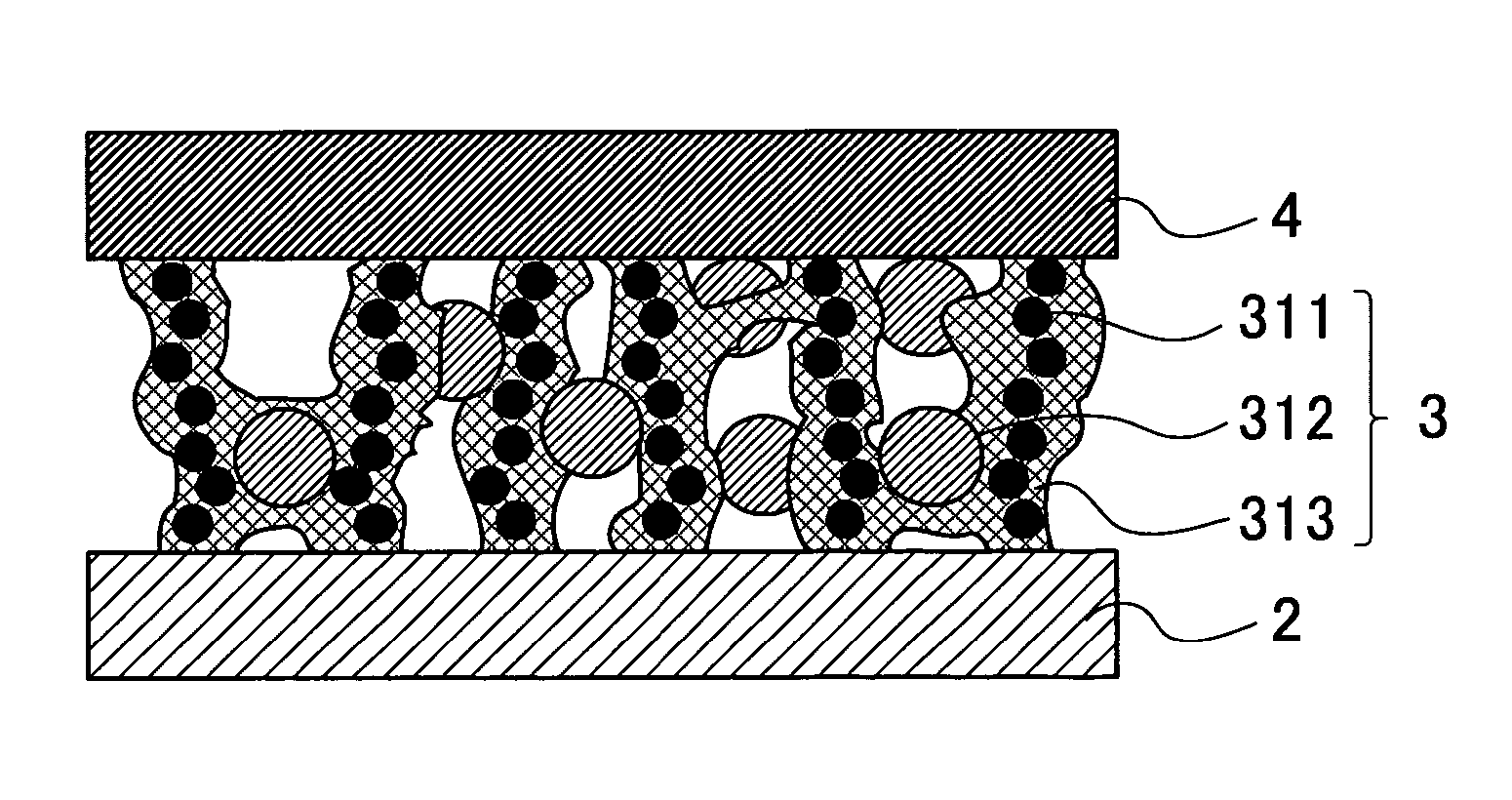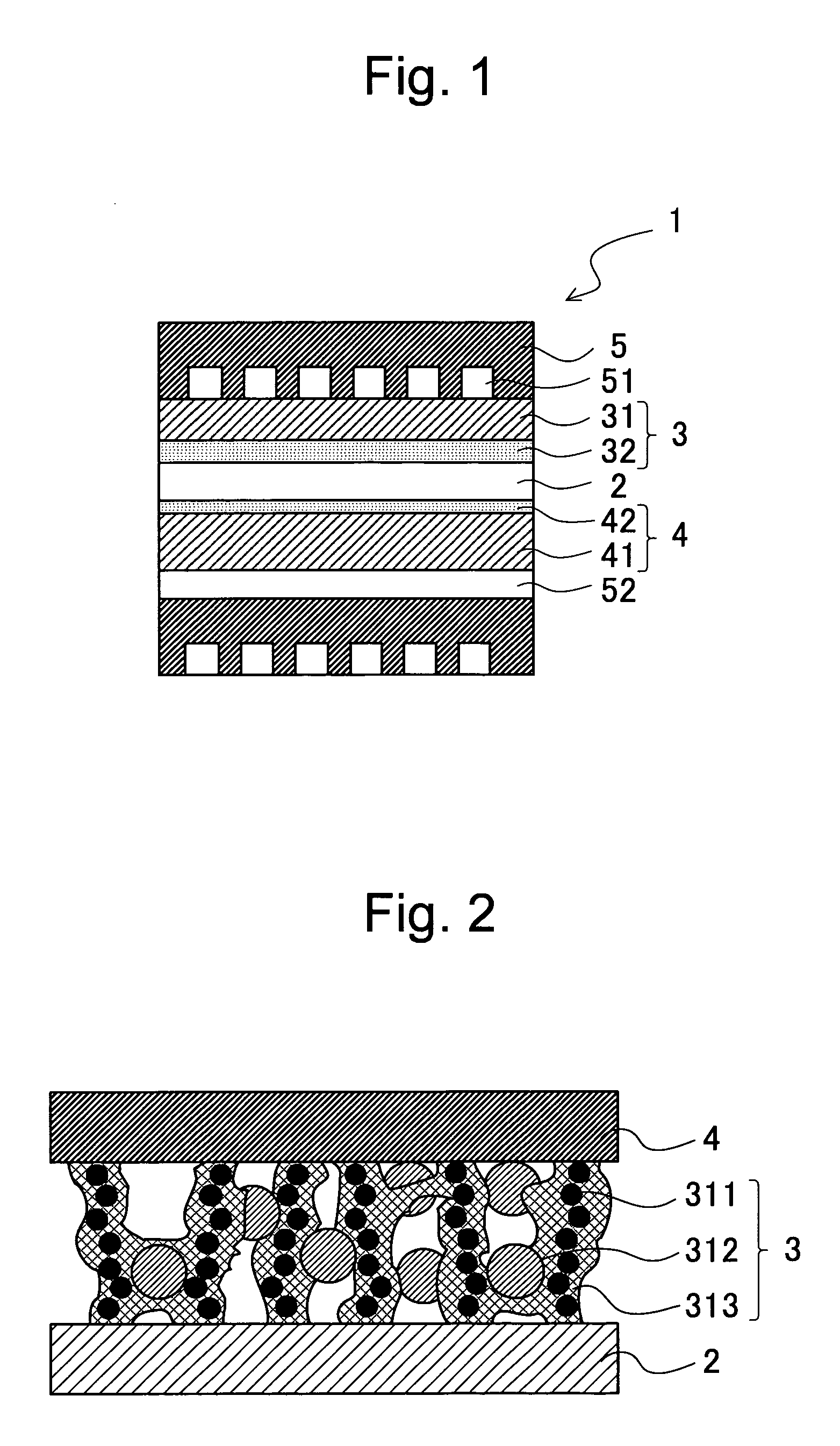Solid polymer electrolyte fuel cell and method for manufacturing the same
a fuel cell and electrolyte technology, applied in the direction of cell components, final product manufacturing, sustainable manufacturing/processing, etc., can solve the problems of difficult system to supply hydrogen, poorly respond to the supply amount, and gas state of hydrogen supplied as a fuel
- Summary
- Abstract
- Description
- Claims
- Application Information
AI Technical Summary
Benefits of technology
Problems solved by technology
Method used
Image
Examples
example
Example 1
Production of a Sample 1
Preparation of cathode electrode
[0050] 35 g of ion conductive polymer (trade name: Nafion SE2020, produced by Du Pont Kabushiki Kaisha), 10 g of platinum support carbon particles (TEC10E50E produced by Tanaka Kikinzoku Kogyo K.K.) in which carbon black and platinum were mixed at a weight ratio of 50:50, and a 2.5 g of crystalline carbon fiber (VGCF produced by Showa Denko K.K.) were mixed in isopropanol to make a cathode catalyst paste. The cathode catalyst paste was applied on the Teflon (FEP) sheet so that it contains 0.3 mg / cm2 of platinum and dried to form an electrode sheet A.
Preparation of Anode Electrode
[0051] In a 5 g of ion conductive polymers (trade name: Nafion SE2021, produced by Du Pont Kabushiki Kaisha) and 1 g of carbon black powder (Ketjenblack by Cabot Corp.), 9 g of catalyst powder Pt-Ru alloy powder, 5 g of pure water, and 10 g of 1-propanol was mixed to make an anode catalyst paste. The anode catalyst paste was applied on t...
example 2
Production of Sample 2
[0055] In 10 g of ion conductive polymers (Nafion SE2021) and 1 g of carbon black powder (Ketjenblack produced by Lion Akzo Co., Inc.), 1 g of crystalline carbon fiber (VGCF produced by Showa Denko K.K.), 8 g of catalyst powder Pt-Ru alloy powder, 5 g of pure water, and 10 g of 1 -propanol was mixed to make an anode catalyst paste. The anode catalyst paste was applied on the FEP sheet so that it contains 0.5 mg / cm2 of catalyst metal and dried to form an electrode sheet B. The electrode sheet B and the previously prepared electrode sheet A sandwiching the electrolyte membrane for transfer printing by way of a decal method to form CCM. The CCM was sandwiched by the previously water-repellent processed diffusion layer to form MEA.
example 3
Production of Sample 3
[0056] The sample was prepared in a similar way as in Example 2 except that 20 g of the ion conductive polymer (Nafion SE2021) was added.
PUM
| Property | Measurement | Unit |
|---|---|---|
| particle size | aaaaa | aaaaa |
| specific surface area | aaaaa | aaaaa |
| specific surface area | aaaaa | aaaaa |
Abstract
Description
Claims
Application Information
 Login to View More
Login to View More - R&D
- Intellectual Property
- Life Sciences
- Materials
- Tech Scout
- Unparalleled Data Quality
- Higher Quality Content
- 60% Fewer Hallucinations
Browse by: Latest US Patents, China's latest patents, Technical Efficacy Thesaurus, Application Domain, Technology Topic, Popular Technical Reports.
© 2025 PatSnap. All rights reserved.Legal|Privacy policy|Modern Slavery Act Transparency Statement|Sitemap|About US| Contact US: help@patsnap.com



